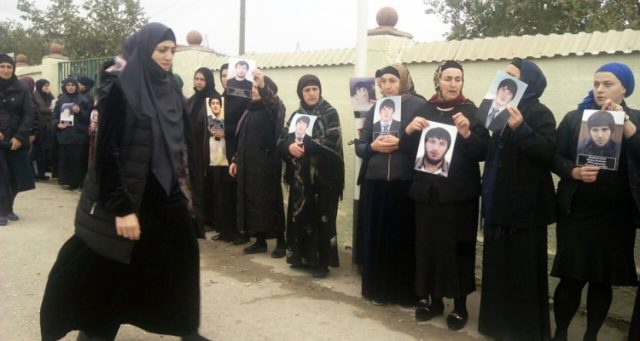
Violence Spirals in North Caucasus After Establishment of Russian National Guard
Publication: Eurasia Daily Monitor Volume: 13 Issue: 167
By:

A significant spike in violence has been registered in the North Caucasus. Within the span of just one week, October 3–9, an estimated 18 people were killed and 4 more suffered injuries in insurgency-related violence across the region. Fifteen suspected rebels, including eight in Chechnya, six in Ingushetia and one in Dagestan, were killed. Two police officers were killed in Kabardino-Balkaria and one in Chechnya. Government forces launched a wave of special operations in the North Caucasus at the start of the month. On October 2, a counter-terrorist operation regime was introduced in Tabasaran district of Dagestan. On October 7, a counter-terrorist operation regime was introduced in parts of the city of Nazran and the village of Gazi-Yurt, in Ingushetia. On October 9, another counter-terrorism operation was launched in Dagestan’s Suleiman-Stalsky district. In two separate episodes, eight suspected militants were kidnapped in Dagestan between the end of September and beginning of October (Kavkazsky Uzel, October 10).
On October 14, relatives of those kidnapped individuals staged a public protest action in the Dagestani town of Khasavyurt, located in the northwestern part of the republic. The police deny that these missing individuals are being held in their custody. At the same time, the officials say that the “disappeared” persons were involved in the activities of the armed underground movement. Relatives of the kidnapped individuals are asking government officials to disclose their location, but so far they have received no response (Chernovik, October 14).
The Russian government has repeatedly stated that insurgency violence in the North Caucasus was declining. However, the massive wave of special operations and kidnappings in recent weeks casts doubt on the authorities’ claims. Some analysists tie this month’s spike in violence in the North Caucasus to recent appointments made to the Russian National Guard—a domestic paramilitary force of 400,000, which President Vladimir Putin announced the creation of earlier this year (see EDM, April 7). Specifically, two well-known figures have been named first deputies to National Guard head Viktor Zolotov: Sergei Melikov, who was until recently Moscow’s envoy to the North Caucasus, and Sergei Chenchik, heretofore a top official in the Ministry of Interior. The two men reportedly compete with each other for power, and Chenchik is apparently more inclined to use crude force against insurgents than Melikov. The latter allegedly favors a combination of “carrots” and “sticks,” while the former is known among the region’s journalists as “the godfather of North Caucasus special operations.” The fact that these newly appointed National Guard deputies both have a history of focusing on the North Caucasus indicates that Moscow remains resolved to deal with the region and to allocate considerable military resources to tackle the situation there. In their competition with one another for recognition from higher-ups, Melikov and Chenchik may be trying to highlight their efficacy at targeting and killing militants (Onkavkaz.com, October 12).
Other experts, however, say that the ongoing spike in violence is related to the growth of the Islamic State (IS) in the region. According to the Moscow-based Dagestani expert on North Caucasus Islam Akhmed Yarlykapov, the IS is less dependent on particular charismatic personalities in its insurgency movement than the Caucasus Emirate was in the past. Hence, it is harder for government forces to target a few key figures and inflict serious operational damage to the organization. Also, unlike the Caucasus Emirate, the IS currently has no competitors in the region and can enjoy a “monopoly” among radicals, Yarlykapov pointed out (Kavkazsky Uzel, October 12).
Meanwhile, different analysts point to a whole combination of factors that may be responsible for the unexpected regional spike in violence. For instance, regional expert Denis Sokolov said that the increased violence should be accepted as a “new normal” in the North Caucasus for several reasons: First, now that Moscow achieved some level of stable equilibrium in its gamble in eastern Ukraine, the North Caucasus is again becoming a target of focus for government forces. Second, he argued, the ongoing outflow of North Caucasus rebels to the Middle East has slowed down due to mounting barriers to their travel as well as the declining appeal of the IS to Russian Muslims. And the outspoken Russian expert on the North Caucasus Orkhan Jamal even asserted that the Russian security services are knowingly ramping up their activities, targeting ordinary Muslims, and antagonizing and radicalizing them in order to justify their high budgets (Kavkazsky Uzel, October 12).
The most recent wave of violence in the North Caucasus indicates that Moscow’s self-proclaimed victory over the insurgency in the region is far from a reality. The Russian security services seem to be continuing their illegal practice of kidnapping suspects, meaning the authorities still have to rely on fear to govern the area. Although government forces currently retain sufficient resources to carry out numerous special operations in the region, it is unclear what will happen when those funds become scarce. The economic situation in the North Caucasus and the entire country is deteriorating; and coupled with the aggressive government campaign against suspected Islamists, all this may result in a rising tide of the insurgency rather than in its looming end.



